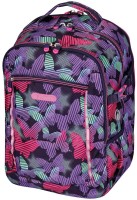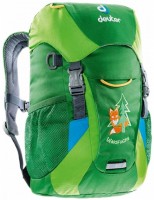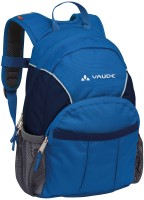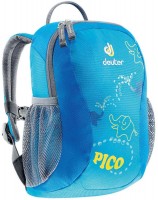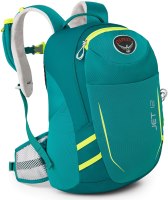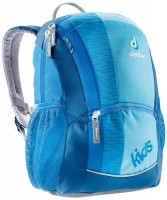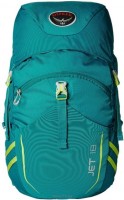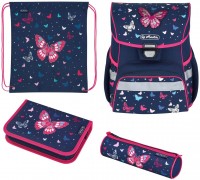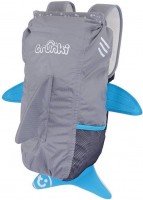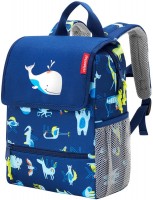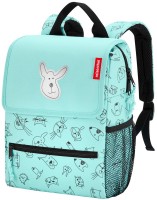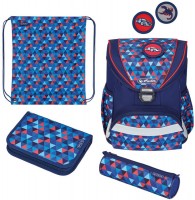School Bags Herlitz
All School Bags Advanced filters → |
You might be interested in
School Bags: specifications, types
Type
— Knapsack. A kind of school bags, designed for the younger age category (mainly students in grades 1-3). Like ordinary backpacks, satchels are regularly worn on two straps behind the shoulders, which allows you to keep your hands free and to some extent helps to maintain your posture. Their distinguishing feature is a rigid frame (see below), which allows the product to retain its shape regardless of fullness. Simply put, the backpack will have the same shape regardless of what lies inside — one notebook, half a dozen textbooks, or a sports uniform with shoes. This feature is extremely important for young children, whose spine is still being formed, and the equipment worn on the back should be as orthopedic as possible.
— Backpack. Classic backpacks — that is, bags that are regularly carried behind the back, on two shoulders (less often — on one, obliquely). Unlike the backpacks described above, they do not have a rigid frame, as a result of which the shape and thickness of the backpack is highly dependent on its current contents. On the other hand, in general, such products are more practical and better suited for middle and high school students. They also have all the advantages of "shoulder" models — the child's hands remain free, and the straps pull the shoulders back and help maintain posture. The latter, however, does not apply to single-strap models — you need to be careful with them, becaus...e. weight distribution is uneven, and long-term wearing of such backpacks is not recommended.
— Bag. Classic bags designed to be carried by hand or on the shoulder. Some consider such products to be more stylish than backpacks, and better suited for youth style (especially urban and other similar trends). But from the point of view of convenience and ergonomics, bags are generally inferior to backpacks, and long-term carrying on one shoulder is highly undesirable; Yes, and they have a slightly smaller capacity. On the other hand, there are also practical advantages: the contents of the bag can be reached without removing it from the shoulder, and this option is not available for a backpack.
— Backpack. Classic backpacks — that is, bags that are regularly carried behind the back, on two shoulders (less often — on one, obliquely). Unlike the backpacks described above, they do not have a rigid frame, as a result of which the shape and thickness of the backpack is highly dependent on its current contents. On the other hand, in general, such products are more practical and better suited for middle and high school students. They also have all the advantages of "shoulder" models — the child's hands remain free, and the straps pull the shoulders back and help maintain posture. The latter, however, does not apply to single-strap models — you need to be careful with them, becaus...e. weight distribution is uneven, and long-term wearing of such backpacks is not recommended.
— Bag. Classic bags designed to be carried by hand or on the shoulder. Some consider such products to be more stylish than backpacks, and better suited for youth style (especially urban and other similar trends). But from the point of view of convenience and ergonomics, bags are generally inferior to backpacks, and long-term carrying on one shoulder is highly undesirable; Yes, and they have a slightly smaller capacity. On the other hand, there are also practical advantages: the contents of the bag can be reached without removing it from the shoulder, and this option is not available for a backpack.
Age group
— For preschoolers. Models designed for the youngest age group — up to 7 years. They have a bright design, as well as small size and capacity — however, large volumes in this case are not needed. With such a backpack, it will be convenient for a child to go to a kindergarten or a preparatory group, inside you can put a change of clothes, drawing supplies, etc.
— For schoolchildren. Backpacks designed mainly for children of primary and secondary school age — from 7 to 12 years. However, some models are suitable for high school students. They are more diverse in terms of equipment than preschool ones, often have more departments (both internal and external), and the volume can be very different — from a small one, 10 liters or less, to 30 liters or even more. This allows you to choose the best option in terms of size and volume, and as the child grows, you can also change the backpack from small to larger and more spacious.
— For teenagers. Backpacks for teenagers aged 12 years and older, in fact — for high school students, and even junior students. They do not have such a “childish” design as the younger models, but they are still quite diverse, they can be discreet, and quite bright and colorful. The volume can also be different — from a few liters to 30 liters or more.
— For schoolchildren. Backpacks designed mainly for children of primary and secondary school age — from 7 to 12 years. However, some models are suitable for high school students. They are more diverse in terms of equipment than preschool ones, often have more departments (both internal and external), and the volume can be very different — from a small one, 10 liters or less, to 30 liters or even more. This allows you to choose the best option in terms of size and volume, and as the child grows, you can also change the backpack from small to larger and more spacious.
— For teenagers. Backpacks for teenagers aged 12 years and older, in fact — for high school students, and even junior students. They do not have such a “childish” design as the younger models, but they are still quite diverse, they can be discreet, and quite bright and colorful. The volume can also be different — from a few liters to 30 liters or more.
Gender
Gender of the child for which the product is designed. This moment practically does not affect the functionality and equipment; first of all, the design depends on it.
Modern school bags, satchels and backpacks can be produced in versions for girls, for boys and unisex (universal). "Girl" models are distinguished by a rather bright appearance, pink, lilac, light green shades are popular in them, as well as romantic, fabulous and various "cute" motifs. "Boys" products have more restrained colours, usually in cool colours (blue, grey, green), and the design theme can relate to cars and various equipment, extreme sports, science fiction, etc. The unisex category, in turn, includes quite a wide variety of models — from neutral-restrained to bright and richly decorated; however, they are all equally well suited for both girls and boys.
Also note that models for which a certain “gender identity” is claimed can also be designed in a neutral style, and classifying them as “boys” or “girls” sometimes depends only on what the manufacturer himself decided about this.
Modern school bags, satchels and backpacks can be produced in versions for girls, for boys and unisex (universal). "Girl" models are distinguished by a rather bright appearance, pink, lilac, light green shades are popular in them, as well as romantic, fabulous and various "cute" motifs. "Boys" products have more restrained colours, usually in cool colours (blue, grey, green), and the design theme can relate to cars and various equipment, extreme sports, science fiction, etc. The unisex category, in turn, includes quite a wide variety of models — from neutral-restrained to bright and richly decorated; however, they are all equally well suited for both girls and boys.
Also note that models for which a certain “gender identity” is claimed can also be designed in a neutral style, and classifying them as “boys” or “girls” sometimes depends only on what the manufacturer himself decided about this.
Lock
A type of lock used on the main compartment(s) of a backpack, satchel, or bag.
— Lightning. Classic zipper, unfastened and fastened by the movement of the dog. Quite a convenient and practical kind of fastener, easy to open and close, moreover, familiar to most children from preschool age. In addition, many models are equipped with twin pawls that allow you to unfasten / fasten the lock from any point, and even leave openings of any size and location; the latter is convenient for carrying bulky items sticking out, such as tennis rackets or tubes with documents. Thanks to all this, zippers are extremely popular in all types of backpacks. Their disadvantage can be called a certain probability of “chewing” the edge of the fabric and jamming, which can be a serious problem for a child, especially a primary school student. However, in many models, especially the middle and highest price categories, zippers are designed in such a way that the likelihood of such a problem is minimal.
— Clasp. The lock is in the form of a small quick-release structure. The most commonly used fastener in the form of a metal loop and a tongue with a spring button. When closing, the tongue is threaded all the way into the loop, the button passes through the loop and snaps up, preventing the tongue from moving and fixing the clasp. To open, you need to press the button, which will allow the tongue to come out of the l...oop. Such locks are popular mainly in backpacks (see "Type"), designed for the younger age category — fasteners are often more convenient for babies than zippers. However, there are other design options — "fastex", as on tourist equipment (a latch opened by pressing on both sides on the sides), a magnet, a carabiner with a loop, a buckle (like on a belt), etc. Some of them are quite difficult and only suitable for middle and high school students. Anyway, the clasp (or pair of clasps) is usually installed on the flap that closes the main compartment of the backpack/bag.
— Screed. Only backpacks are equipped with this type of locks (see "Type"). The product with a screed has the form of a soft bag, in the neck of which a rope is threaded around the perimeter. To close the backpack, you need to tighten the rope, to open it, stretch the neck by hand. Often, the design provides for additional devices that “make life easier” for the owner — for example, a latch with a button that holds the tightened rope in place. The screed does not have any special practical advantages over the same zipper, but some people like this option more — it gives the backpack an original appearance, and sometimes it turns out to be more convenient from the practical point of view. Note that models with a tie often also have a valve on the clasp (see above), but in this case the clasp plays an auxiliary role and is not taken into account.
— Lightning. Classic zipper, unfastened and fastened by the movement of the dog. Quite a convenient and practical kind of fastener, easy to open and close, moreover, familiar to most children from preschool age. In addition, many models are equipped with twin pawls that allow you to unfasten / fasten the lock from any point, and even leave openings of any size and location; the latter is convenient for carrying bulky items sticking out, such as tennis rackets or tubes with documents. Thanks to all this, zippers are extremely popular in all types of backpacks. Their disadvantage can be called a certain probability of “chewing” the edge of the fabric and jamming, which can be a serious problem for a child, especially a primary school student. However, in many models, especially the middle and highest price categories, zippers are designed in such a way that the likelihood of such a problem is minimal.
— Clasp. The lock is in the form of a small quick-release structure. The most commonly used fastener in the form of a metal loop and a tongue with a spring button. When closing, the tongue is threaded all the way into the loop, the button passes through the loop and snaps up, preventing the tongue from moving and fixing the clasp. To open, you need to press the button, which will allow the tongue to come out of the l...oop. Such locks are popular mainly in backpacks (see "Type"), designed for the younger age category — fasteners are often more convenient for babies than zippers. However, there are other design options — "fastex", as on tourist equipment (a latch opened by pressing on both sides on the sides), a magnet, a carabiner with a loop, a buckle (like on a belt), etc. Some of them are quite difficult and only suitable for middle and high school students. Anyway, the clasp (or pair of clasps) is usually installed on the flap that closes the main compartment of the backpack/bag.
— Screed. Only backpacks are equipped with this type of locks (see "Type"). The product with a screed has the form of a soft bag, in the neck of which a rope is threaded around the perimeter. To close the backpack, you need to tighten the rope, to open it, stretch the neck by hand. Often, the design provides for additional devices that “make life easier” for the owner — for example, a latch with a button that holds the tightened rope in place. The screed does not have any special practical advantages over the same zipper, but some people like this option more — it gives the backpack an original appearance, and sometimes it turns out to be more convenient from the practical point of view. Note that models with a tie often also have a valve on the clasp (see above), but in this case the clasp plays an auxiliary role and is not taken into account.
Capacity
The total volume of the product. It can be indicated both with external pockets and without them (see "Compartments") — this is not critical in this case, because the capacity of the pockets is small and does not really affect the overall capacity. But the external compartment (see ibid.) is necessarily taken into account in the characteristics, since it accounts for a fairly significant part of the volume.
Larger capacity allows you to carry more items inside. On the other hand, for pupils of primary and secondary grades, capacious backpacks are not required, and a heavy load can be harmful to health and normal development. Therefore, the volume largely depends on the age category. Thus, the volume of backpacks (see "Type"), which were originally designed for the younger age group, rarely exceeds 20 liters, and in most cases is less than 15 liters. The same applies to bags, but in their case it is more likely due to design features, and the volume is generally larger — up to 29 liters. Backpacks are the most voluminous — among them models of 25 liters are not uncommon, and in some the volume exceeds 30 liters. However, the choice of volume depends not only on the age category, but also on the expected amount of cargo. So, a high school student may not need a roomy backpack if the school has lockers and textbooks are mostly stored there.
Larger capacity allows you to carry more items inside. On the other hand, for pupils of primary and secondary grades, capacious backpacks are not required, and a heavy load can be harmful to health and normal development. Therefore, the volume largely depends on the age category. Thus, the volume of backpacks (see "Type"), which were originally designed for the younger age group, rarely exceeds 20 liters, and in most cases is less than 15 liters. The same applies to bags, but in their case it is more likely due to design features, and the volume is generally larger — up to 29 liters. Backpacks are the most voluminous — among them models of 25 liters are not uncommon, and in some the volume exceeds 30 liters. However, the choice of volume depends not only on the age category, but also on the expected amount of cargo. So, a high school student may not need a roomy backpack if the school has lockers and textbooks are mostly stored there.
More features
Items included in the package in addition to the bag itself, backpack or knapsack. Usually, they are made in the same style as the main product, and from the same materials (or from similar ones).
— Sports bag. Additional bag designed to carry a change of clothes for sports. Such products can have a different design — from the simplest fabric bag with a tie to a stylish accessory on a belt, reminiscent of a smaller version of a full-size "adult" sports bag. Anyway, a sports bag will be useful even during regular physical education, not to mention visiting sections — it is quite convenient to wear a uniform in it, and you don’t have to look for another “package” for this.
— Pencil case. A pencil case is a small case for storing pens, pencils, erasers and other similar “little things”. There are several types of pencil cases, one of the most popular is just a pencil case-book. As the name suggests, it consists of two halves that open like a book cover. On the inside of each half are "seats" for the contents, usually in the form of loops. The advantage of a pencil case-book over a pencil case is, first of all, a large capacity; Yes, and a flat shape in some cases is quite convenient. On the other hand, in general, such cases take up much more space.
— Pencil case. Pencil case in the form of an oblong fabric case, usually with a zipper. It usually ho...lds noticeably fewer items than the pencil case described above, and it can be somewhat more difficult to get to them; however, the pencil case has a more compact size, and an oblong shape is sometimes preferable to a flat one.
— Wallet. A classic wallet that allows you to store a certain amount of money, and often also several plastic cards (for example, a credit card, a travel card or a pass to the library). The capacity of wallets is usually noticeably smaller than that of adult models, but in most cases this is quite enough for a child.
— Lunch box. Container for school lunches. You can use a regular food tray to carry food, but specialized containers are usually more convenient and enjoyable. So, lunch boxes usually have several compartments, which allows you to load different types of products — for example, salad, main course and dessert. Yes, and their appearance is more consistent with the school style.
— Sports bag. Additional bag designed to carry a change of clothes for sports. Such products can have a different design — from the simplest fabric bag with a tie to a stylish accessory on a belt, reminiscent of a smaller version of a full-size "adult" sports bag. Anyway, a sports bag will be useful even during regular physical education, not to mention visiting sections — it is quite convenient to wear a uniform in it, and you don’t have to look for another “package” for this.
— Pencil case. A pencil case is a small case for storing pens, pencils, erasers and other similar “little things”. There are several types of pencil cases, one of the most popular is just a pencil case-book. As the name suggests, it consists of two halves that open like a book cover. On the inside of each half are "seats" for the contents, usually in the form of loops. The advantage of a pencil case-book over a pencil case is, first of all, a large capacity; Yes, and a flat shape in some cases is quite convenient. On the other hand, in general, such cases take up much more space.
— Pencil case. Pencil case in the form of an oblong fabric case, usually with a zipper. It usually ho...lds noticeably fewer items than the pencil case described above, and it can be somewhat more difficult to get to them; however, the pencil case has a more compact size, and an oblong shape is sometimes preferable to a flat one.
— Wallet. A classic wallet that allows you to store a certain amount of money, and often also several plastic cards (for example, a credit card, a travel card or a pass to the library). The capacity of wallets is usually noticeably smaller than that of adult models, but in most cases this is quite enough for a child.
— Lunch box. Container for school lunches. You can use a regular food tray to carry food, but specialized containers are usually more convenient and enjoyable. So, lunch boxes usually have several compartments, which allows you to load different types of products — for example, salad, main course and dessert. Yes, and their appearance is more consistent with the school style.
Branches
Additional compartments provided in the design of the product (in addition to the main one).
— External. Additional compartment with a separate fastener, located on the outside of the backpack (on the opposite side from the back). It can have different sizes: most often, the outer compartment occupies the entire height and width of the backpack, but in some models it is made in the form of a relatively small additional pocket. Anyway, this feature allows you to organize the contents of the backpack by placing it in the appropriate compartments: for example, you can keep textbooks in a larger compartment, notebooks in a smaller one.
— Penal. A small outer compartment designed for any small things; the name "pencil case" hints at the fact that it is designed for pens, pencils, erasers and other stationery, but in fact you can hold any small items there. Thanks to this, they are not lost in the main compartment, and you can get to the contents of the pencil case quite easily and quickly. Moreover, an organizer can be provided inside — a set of pockets for stationery; however, in some backpacks, the organizer is placed in the main or external compartment. Do not confuse this function with a separate pencil case (see "Additional") — we are talking about the built-in compartment.
— Bottle pocket. A separate pocket for carrying bottles and other items o...f a similar shape — thermoses, umbrellas, etc. It is usually located outside, on the side end of the product, and is made in the form of an elastic mesh capable of "holding" the object placed inside. Often there are two such pockets, on both sides. The bottle pocket is convenient because you can get to its contents without opening the main compartments, and with a certain skill, even without removing the entire backpack: just remove one strap and put your hand behind your back. In some models, one of the bottle pockets is also regularly used as a seat for a complete pencil case (see "Additional").
— Side pocket. Like the pocket for a bottle (see above), such a pocket is located on the side end and there may be more than one. The main difference lies primarily in the form and purpose: side pockets are usually made for flat and/or small items. In addition, they are often equipped with zippers or other closing devices. The side pocket is usually not connected to the main compartment, it is convenient to store various small things in it, which can be “lost” inside the bag / knapsack / backpack, or which need quick access.
— Hidden pocket. A secret pocket, usually, is located on the back of the backpack. Thus, when the backpack hangs on the shoulders, the pocket is hidden from view and from access to the contents. This is especially convenient when carrying small valuable items, because. gives maximum protection against theft.
— Internal dividers. Partitions dividing the main compartment of the backpack into several parts. This design makes it easier to put the contents in order: for example, textbooks, notebooks and inventory for a labor lesson can be separated by partitions. At the same time, partitions are more convenient than the division into the main and outer compartments (see above): just open the backpack — and all the contents will immediately be at hand, you do not have to unfasten / fasten each compartment separately. Also note that one of the separators can block off a special seat for a laptop or tablet.
— External. Additional compartment with a separate fastener, located on the outside of the backpack (on the opposite side from the back). It can have different sizes: most often, the outer compartment occupies the entire height and width of the backpack, but in some models it is made in the form of a relatively small additional pocket. Anyway, this feature allows you to organize the contents of the backpack by placing it in the appropriate compartments: for example, you can keep textbooks in a larger compartment, notebooks in a smaller one.
— Penal. A small outer compartment designed for any small things; the name "pencil case" hints at the fact that it is designed for pens, pencils, erasers and other stationery, but in fact you can hold any small items there. Thanks to this, they are not lost in the main compartment, and you can get to the contents of the pencil case quite easily and quickly. Moreover, an organizer can be provided inside — a set of pockets for stationery; however, in some backpacks, the organizer is placed in the main or external compartment. Do not confuse this function with a separate pencil case (see "Additional") — we are talking about the built-in compartment.
— Bottle pocket. A separate pocket for carrying bottles and other items o...f a similar shape — thermoses, umbrellas, etc. It is usually located outside, on the side end of the product, and is made in the form of an elastic mesh capable of "holding" the object placed inside. Often there are two such pockets, on both sides. The bottle pocket is convenient because you can get to its contents without opening the main compartments, and with a certain skill, even without removing the entire backpack: just remove one strap and put your hand behind your back. In some models, one of the bottle pockets is also regularly used as a seat for a complete pencil case (see "Additional").
— Side pocket. Like the pocket for a bottle (see above), such a pocket is located on the side end and there may be more than one. The main difference lies primarily in the form and purpose: side pockets are usually made for flat and/or small items. In addition, they are often equipped with zippers or other closing devices. The side pocket is usually not connected to the main compartment, it is convenient to store various small things in it, which can be “lost” inside the bag / knapsack / backpack, or which need quick access.
— Hidden pocket. A secret pocket, usually, is located on the back of the backpack. Thus, when the backpack hangs on the shoulders, the pocket is hidden from view and from access to the contents. This is especially convenient when carrying small valuable items, because. gives maximum protection against theft.
— Internal dividers. Partitions dividing the main compartment of the backpack into several parts. This design makes it easier to put the contents in order: for example, textbooks, notebooks and inventory for a labor lesson can be separated by partitions. At the same time, partitions are more convenient than the division into the main and outer compartments (see above): just open the backpack — and all the contents will immediately be at hand, you do not have to unfasten / fasten each compartment separately. Also note that one of the separators can block off a special seat for a laptop or tablet.
Design
— Rigid frame. The presence of a rigid frame is mandatory for knapsacks, but can also be found in backpacks. In knapsacks, it is used to constantly maintain the same shape, as comfortable and safe as possible from an orthopedic point of view. In backpacks, a rigid frame is used to protect the contents from impacts, especially side impacts.
— Folding. Models that are able to unfasten to the very bottom and open like a book. Usually, the role of the lock in such products is played by a “lightning” that goes on top and on the sides of the backpack. The folding design makes accessing the contents more convenient and can make loading and unloading and searching for items inside much easier.
— Orthopedic back. The back of a special "orthopedic" shape, thanks to which the load is distributed over the child's back in the most optimal and safe way. In addition, the surface of such backs is usually embossed, which improves ventilation and reduces sweating. Note that "non-orthopedic" backs can be quite comfortable.
— Chest strap. Attachment in the form of a strap with a clasp that connects the main straps of the backpack at the level of the user's chest. When fastened, such a strap keeps the straps at the same distance from each other and does not allow them to “scatter”. This provides additional convenience in the distribu...tion of weight, as well as a secure fit on the body.
— Waist belt. An additional device in the form of a belt, which, when fastened, covers the user's body in the belt area. Thus, the load is redistributed from the shoulders to the pelvic area, which is especially convenient when carrying heavy backpacks. In addition, such a device provides additional reliability of fixing the backpack on the body.
— Soft straps. In this case, straps are meant that have additional soft pads made of foam rubber or other similar material. Thanks to this material, as well as the increased width, such straps do not cut into the shoulders and remain comfortable even with a fairly large weight, and the load is distributed more optimally than on straps without pads.
— S-shaped straps. S-shaped shoulder straps (when viewed from the back of the backpack). It is believed that this form provides a more rational distribution of the load than the sickle-shaped, and even more so the classic straight line, it gives more freedom to the hands and prevents the backpack from slipping off the shoulders. In addition, S-shaped straps are easier to equip with chest straps.
— Rain protection. A device that protects the backpack (and its contents) from rain, snow and other natural “troubles”. Usually, it has the form of a “hood” or a cover made of waterproof material, which, if necessary, is put on top and provides additional protection. Note that almost any backpack / knapsack / bag is able to protect the contents from moisture to a certain extent; however, for maximum weather resistance, you should still choose models in which this feature is directly stated.
— LED backlight. The backpack is equipped with built-in lighting, which, usually, is represented by an LED strip located in a straight line. On the one hand, the backlight has a decorative effect and makes the backpack itself more attractive to children. On the other hand, it can act as an identification mark, for example, when crossing the roadway, and in general increases the visibility of the child on the road at night
— Reflector. Special reflective inserts, located, usually, on all sides of the product — for example, in backpacks and satchels they are installed on the straps, on the outside and on the sides. Such inserts brightly "flash" in the light of car headlights, making the child clearly visible to drivers in the dark. The features of night driving and vision are such that reflectors will not be superfluous even on a lit street, not to mention darker environments. And in some countries, traffic rules even forbid pedestrians to move at night without reflectors. Anyway, this feature can be very useful from a security point of view.
— Folding. Models that are able to unfasten to the very bottom and open like a book. Usually, the role of the lock in such products is played by a “lightning” that goes on top and on the sides of the backpack. The folding design makes accessing the contents more convenient and can make loading and unloading and searching for items inside much easier.
— Orthopedic back. The back of a special "orthopedic" shape, thanks to which the load is distributed over the child's back in the most optimal and safe way. In addition, the surface of such backs is usually embossed, which improves ventilation and reduces sweating. Note that "non-orthopedic" backs can be quite comfortable.
— Chest strap. Attachment in the form of a strap with a clasp that connects the main straps of the backpack at the level of the user's chest. When fastened, such a strap keeps the straps at the same distance from each other and does not allow them to “scatter”. This provides additional convenience in the distribu...tion of weight, as well as a secure fit on the body.
— Waist belt. An additional device in the form of a belt, which, when fastened, covers the user's body in the belt area. Thus, the load is redistributed from the shoulders to the pelvic area, which is especially convenient when carrying heavy backpacks. In addition, such a device provides additional reliability of fixing the backpack on the body.
— Soft straps. In this case, straps are meant that have additional soft pads made of foam rubber or other similar material. Thanks to this material, as well as the increased width, such straps do not cut into the shoulders and remain comfortable even with a fairly large weight, and the load is distributed more optimally than on straps without pads.
— S-shaped straps. S-shaped shoulder straps (when viewed from the back of the backpack). It is believed that this form provides a more rational distribution of the load than the sickle-shaped, and even more so the classic straight line, it gives more freedom to the hands and prevents the backpack from slipping off the shoulders. In addition, S-shaped straps are easier to equip with chest straps.
— Rain protection. A device that protects the backpack (and its contents) from rain, snow and other natural “troubles”. Usually, it has the form of a “hood” or a cover made of waterproof material, which, if necessary, is put on top and provides additional protection. Note that almost any backpack / knapsack / bag is able to protect the contents from moisture to a certain extent; however, for maximum weather resistance, you should still choose models in which this feature is directly stated.
— LED backlight. The backpack is equipped with built-in lighting, which, usually, is represented by an LED strip located in a straight line. On the one hand, the backlight has a decorative effect and makes the backpack itself more attractive to children. On the other hand, it can act as an identification mark, for example, when crossing the roadway, and in general increases the visibility of the child on the road at night
— Reflector. Special reflective inserts, located, usually, on all sides of the product — for example, in backpacks and satchels they are installed on the straps, on the outside and on the sides. Such inserts brightly "flash" in the light of car headlights, making the child clearly visible to drivers in the dark. The features of night driving and vision are such that reflectors will not be superfluous even on a lit street, not to mention darker environments. And in some countries, traffic rules even forbid pedestrians to move at night without reflectors. Anyway, this feature can be very useful from a security point of view.
Cartoon style
Models inspired by cartoons or in a similar style, such as popular culture characters or original drawings using "cartoon" motifs. Many children (especially elementary school students) like such products more than neutral ones. And if a child is a fan of a certain cartoon, a themed backpack / bag / knapsack can be a very valuable gift for him.
Material
The main material used in the construction of the product.
Note that any material in backpacks / knapsacks / bags of proper quality will be strong and durable enough to be used for its intended purpose. Therefore, this parameter is often non-critical, and sometimes the choice of material is associated primarily with the appearance of the product.
— Polyester. Synthetic material, the properties of which can be estimated at least by the fact that it is widely used in tourist backpacks and other equipment. Polyester-based fibre has good strength characteristics, tolerates moisture and temperature changes without problems, is resistant to ultraviolet radiation and has a relatively low cost. Polyester threads may vary in composition and thickness; usually, the more expensive the product, the more high-quality type of fibre is used in it.
— Nylon. Another "tourist" material of synthetic origin. By itself, nylon has somewhat more modest characteristics than polyester — in particular, it is not as durable and tends to stretch when wet. However, these shortcomings are often compensated by various design solutions; in fact, the characteristics of nylon also directly depend on the price category of the product.
— Polyurethane. A polymeric material that can be used both as a solid surface and as a fibre. However, in this case we are talking only about the first option. School backpacks usually use soft and highly elastic grades of polyurethane. The...advantages of this material are complete waterproofness and high elasticity, and many varieties are able to maintain their presentation even after stretching. And in some models, polyurethane even resembles leather, despite the fact that it is much cheaper and does not require special care. On the other hand, this material is still quite expensive, and not everyone likes its appearance. Therefore, it did not receive much distribution.
— Leatherette. A man-made material that mimics the look and feel of real leather. The main advantage of "leatherette" is the lower cost; in addition, this material does not require special care, and for some it is also important that animals do not die during production. However the durability and abrasion resistance of artificial leather is generally lower than that of natural; however, there are many varieties of this material on the market, and the most expensive and advanced in their properties can come close to the natural counterpart. It should be noted that many leatherette bags and backpacks are made in a “glamorous” style and are designed for high school students who follow fashion.
— Cotton. A natural material that is valued by some precisely for its origin — as opposed to synthetics. However, cotton has other advantages: it is quite durable, pleasant to the touch and in appearance, calmly tolerates contact with moisture, ultraviolet radiation and temperature changes. On the other hand, the reliability of this material is somewhat lower than that of nylon and polyester, the weight is noticeably greater, and there is usually no talk of water resistance at all. Therefore, cotton has not received much distribution in school backpacks, bags and knapsacks; it is usually used more as an original design solution than for practical reasons.
— Polyspandex. Synthetic fibre, consisting mainly of polyester with the addition of (8 – 10%) spandex — polyurethane fibre. The features of polyspandex in comparison with other synthetic materials are extremely high elasticity and the ability to endure repeated stretching without consequences.
— Textile. The word "textile" refers to a variety of types of fabrics and non-woven materials. Usually, this category includes materials that do not belong to any of the types described above — for example, felt (felt wool), a dense fabric such as denim, but not made of cotton, etc. The specific composition and features of the "textile" for each model should be specified separately.
— Tarpaulin. Heavy and dense fabric, usually natural (cotton or linen) — impregnated with special compounds to provide water-repellent properties. Usually tarp is not completely waterproof, but a backpack made of such material is not afraid even for quite a long time in the rain. Among other advantages, one can note a stylish appearance, a general impression of solidity, strength, reliability and durability. At the same time, the tarpaulin is quite heavy and poorly suited for products in a bright design. Therefore, it is used relatively rarely, mainly in backpacks of the older age group.
— Taslan. A type of synthetic fabric based on nylon. It is positioned as a fairly advanced material that provides both water resistance and good ventilation, besides, it is characterized by good strength with low weight. However, few products from taslan are produced: such properties are important mainly for clothing, and more traditional types of fabrics are better suited for backpacks and knapsacks.
Note that any material in backpacks / knapsacks / bags of proper quality will be strong and durable enough to be used for its intended purpose. Therefore, this parameter is often non-critical, and sometimes the choice of material is associated primarily with the appearance of the product.
— Polyester. Synthetic material, the properties of which can be estimated at least by the fact that it is widely used in tourist backpacks and other equipment. Polyester-based fibre has good strength characteristics, tolerates moisture and temperature changes without problems, is resistant to ultraviolet radiation and has a relatively low cost. Polyester threads may vary in composition and thickness; usually, the more expensive the product, the more high-quality type of fibre is used in it.
— Nylon. Another "tourist" material of synthetic origin. By itself, nylon has somewhat more modest characteristics than polyester — in particular, it is not as durable and tends to stretch when wet. However, these shortcomings are often compensated by various design solutions; in fact, the characteristics of nylon also directly depend on the price category of the product.
— Polyurethane. A polymeric material that can be used both as a solid surface and as a fibre. However, in this case we are talking only about the first option. School backpacks usually use soft and highly elastic grades of polyurethane. The...advantages of this material are complete waterproofness and high elasticity, and many varieties are able to maintain their presentation even after stretching. And in some models, polyurethane even resembles leather, despite the fact that it is much cheaper and does not require special care. On the other hand, this material is still quite expensive, and not everyone likes its appearance. Therefore, it did not receive much distribution.
— Leatherette. A man-made material that mimics the look and feel of real leather. The main advantage of "leatherette" is the lower cost; in addition, this material does not require special care, and for some it is also important that animals do not die during production. However the durability and abrasion resistance of artificial leather is generally lower than that of natural; however, there are many varieties of this material on the market, and the most expensive and advanced in their properties can come close to the natural counterpart. It should be noted that many leatherette bags and backpacks are made in a “glamorous” style and are designed for high school students who follow fashion.
— Cotton. A natural material that is valued by some precisely for its origin — as opposed to synthetics. However, cotton has other advantages: it is quite durable, pleasant to the touch and in appearance, calmly tolerates contact with moisture, ultraviolet radiation and temperature changes. On the other hand, the reliability of this material is somewhat lower than that of nylon and polyester, the weight is noticeably greater, and there is usually no talk of water resistance at all. Therefore, cotton has not received much distribution in school backpacks, bags and knapsacks; it is usually used more as an original design solution than for practical reasons.
— Polyspandex. Synthetic fibre, consisting mainly of polyester with the addition of (8 – 10%) spandex — polyurethane fibre. The features of polyspandex in comparison with other synthetic materials are extremely high elasticity and the ability to endure repeated stretching without consequences.
— Textile. The word "textile" refers to a variety of types of fabrics and non-woven materials. Usually, this category includes materials that do not belong to any of the types described above — for example, felt (felt wool), a dense fabric such as denim, but not made of cotton, etc. The specific composition and features of the "textile" for each model should be specified separately.
— Tarpaulin. Heavy and dense fabric, usually natural (cotton or linen) — impregnated with special compounds to provide water-repellent properties. Usually tarp is not completely waterproof, but a backpack made of such material is not afraid even for quite a long time in the rain. Among other advantages, one can note a stylish appearance, a general impression of solidity, strength, reliability and durability. At the same time, the tarpaulin is quite heavy and poorly suited for products in a bright design. Therefore, it is used relatively rarely, mainly in backpacks of the older age group.
— Taslan. A type of synthetic fabric based on nylon. It is positioned as a fairly advanced material that provides both water resistance and good ventilation, besides, it is characterized by good strength with low weight. However, few products from taslan are produced: such properties are important mainly for clothing, and more traditional types of fabrics are better suited for backpacks and knapsacks.
Weight
Empty weight. This parameter has a dual meaning. On the one hand, the lower the own weight of a backpack, bag or knapsack, the less load will be on the shoulders of the child with the same weight of the load. On the other hand, with the same materials, a lighter product is also thinner and, accordingly, less durable.

